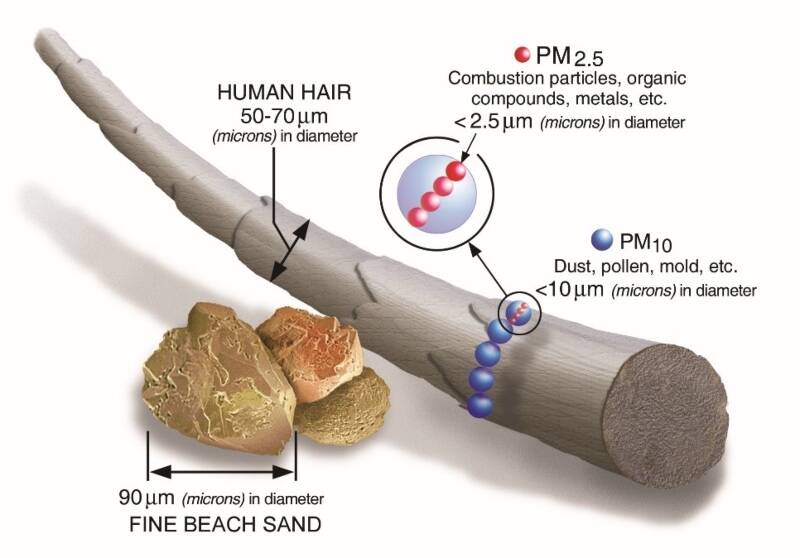One unfortunate result of summer having arrived earlier than expected this year is wildfires.
In addition to the many fires already burning across the U.S., nearly 100 wildfires have been raging in Alberta since the beginning of March, burning over two million acres so far.
Depending on weather patterns, the hazy skies recently seen over Vashon can be expected to recur periodically until the Alberta wildfires are extinguished. Experts predict that those wildfires may drag on through summer.
Wildfire smoke contains a complex mixture of gases, hazardous air pollutants, and fine particulate matter that may cause serious health effects when inhaled. The smallest particulate matter (known as PM 2.5) can even enter the bloodstream. The people at greatest risk of negative health effects from breathing wildfire smoke include those with cardiovascular or respiratory disease, older adults, children under 18 years of age, pregnant women, and outdoor workers.
Exposure to larger particles that are also in wildfire smoke can irritate the eyes, nose, and mouth. See the EPA’s article on wildfire smoke for more information here.
What you can do:
- Check AirNOW.gov for daily air quality information for our area. Close windows and seal up air leaks to keep smoke out of the house.
- Get air purifiers going again. Run them in the rooms where you spend the most time. Make an air cleaner from a box fan and one or more 2” thick MERV-13 furnace filters, found here. Remember to clean or replace filters, following manufacturer instructions.
- Wear an N95-rated mask if air quality reports are not good but you need to be outside.
- Consider exercising indoors on smoky days.
- Consider postponing recreational fires, especially those that burn wood.
- Check the VIFR.org website for burn ban status. Take green yard waste to the transfer station, or compost it in the yard, rather than burning it.
Building Ventilation: A Big Win from Pandemic Response
In a major public health advance, the U.S. Centers for Disease Control and Prevention (CDC) recently published updated guidance for ventilating buildings to reduce the risks from indoor transmission of airborne viruses.
The guidance includes the goal of completing five complete air changes per hour (compared to most homes, which change only half a room’s air per hour), and upgrading ventilation systems to use air filters rated as MERV-13.
The recommendations also include keeping ventilation fans set to On rather than Auto, keeping windows open when possible, installing ultraviolet (UV) air purification systems, and monitoring for carbon dioxide (because the density of CO2 levels is used as a proxy for the density of airborne pathogens).
The American Society of Heating, Refrigerating and Air-Conditioning Engineers (ASHRAE) boosted the CDC’s recommendations by releasing their own proposed new standards for building ventilation. Those recommendations are expected to be finalized in July. These new guidelines were a direct result of knowledge about airborne viruses gained from the COVID-19 pandemic.
For the first time ever, these authorities are setting specific, measurable goals for indoor air quality that will help in many ways. With vastly improved building ventilation and air purification, schools and businesses will be able to use air quality measurements to decide when it’s safe to stay open despite a disease outbreak.
Publishing safer building air quality measurements may reassure people who are using a building. Achieving the new targets will also mean more relief for people who suffer from allergies and asthma. Higher oxygen levels from good ventilation will improve cognitive performance for people working or studying in buildings that follow the new standards.
Prep Tip: Practice Wildfire Evacuation Routes
In previous prep tips, we’ve described how to assemble an emergency supply kit and place it in a safe spot. We’ve described the important documents, medications and personal identification to include. These are good preliminary steps to take when planning for evacuation in case of wildfire.
- Develop an emergency evacuation plan, and practice it with everyone in your home.
- Plan two ways out of your neighborhood and designate a meeting place. One of the ways out should be on foot, in case roads are blocked by traffic, fire, or fallen debris.
- Vashon Island Fire & Rescue recently sponsored a free wildfire readiness class. Watch for repeats of this class, and get more info here.
COVID Basic Risk Level
VashonBePrepared’s risk level tool is based mostly on COVID hospitalization rates. Some other factors are also evaluated, including COVID virus levels in wastewater in our region.
At the Basic Risk Level, it is recommended to wear an N95 mask indoors in public if you are exposed to COVID or at risk for health or other reasons, or live with or spend time with someone at high risk.
Keep vaccinations up to date, including boosters. Maintain good ventilation at home and at work, and avoid those with suspected or confirmed COVID.
If exposed to COVID, wear a mask in public and avoid contact with those at high risk for 10 days.
Always home-test if you have symptoms. If you test positive, isolate for at least five days and until you test negative. If immunocompromised, discuss additional prevention actions with your healthcare provider.


